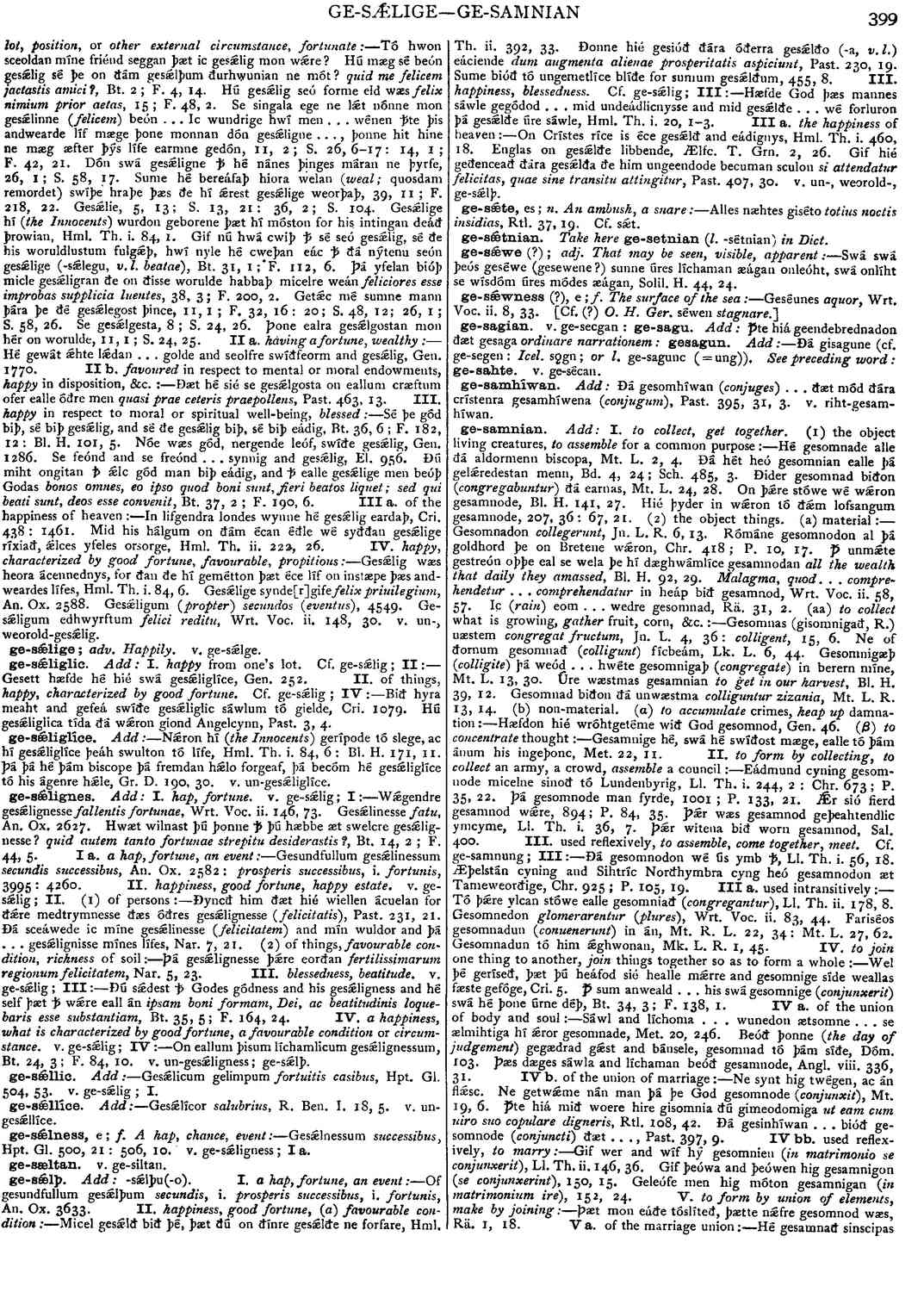ge-samnian
- verb [ weak ]
-
Hé gesomnade alle ðá aldormenn biscopa,
- Mt. L. 2, 4.
-
Ðá hét heó gesomnian ealle þá gelǽredestan menn,
- Bd. 4, 24 ; Sch. 485, 3.
-
Ðider gesomnad biðon
(congregabuntur)
ðá earnas.- Mt. L. 24, 28.
-
On þǽre stówe wé wǽron gesamnode,
- Bl. H. 141, 27.
-
Hié þyder in wǽron tó ðǽm lofsangum gesamnode,
- 207, 36; 67, 21.
-
Gesomnadon
collegerunt,
- Jn. L. R. 6, 13.
-
Rómáne gesomnodon al þá goldhord þe on Bretene wǽron,
- Chr. 418 ; P. 10, 17.
-
Ꝥ unmǽte gestreón oþþe eal se wela þe hí dæghwámlíce gesamnodan all the wealth that daily they amassed, Bl. H. 92, 29.
Malagma, quod. . . comprehendetur . . . comprehendatur
in heáp bið gesamnod,- Wrt. Voc. ii. 58, 57.
-
Ic (rain) eom . . . wedre gesomnad, Rá. 31, 2. (aa) to collect what is growing, gather fruit, corn, & c. :-- Gesomnas (gisoronigað, R. ) uæstem congregat fructum, jn. L. 4, 36:
colligent,
- 15, 6.
-
Ne of ðornum gesomnað
(colligunt)
fícbeám.- Lk. L. 6, 44.
-
Gesomnigæþ (colligite) þá weód . . . hwéte gesomnigaþ
(congregate)
in berern mine,- Mt. L. 13, 30.
-
Úre wæstmas gesamnian
to get in our harvest.
- Bl. H. 39, 12.
-
Gesomnad biðon ðá unwæstma
colliguntur zizania,
- Mt. L. R. 13, 14.
-
Hæfdon hié wróhtgetéme wið God gesomnod, Gen. 46.
β to concentrate
thought :-- Gesamnige hé, swá hé swíðost mæge, ealle tó þám ánum his ingeþonc.- Met. 22, ii.
-
Eádmund cyning gesomnode micelne sinoð tó Lundenbyrig,
- Ll. Th. i. 244, 2 : Chr. 673 ; P. 35, 22. þá gesomnode man fyrde, 1001 ; P. 133, 21.
-
Ǽr sió fierd gesamnod wǽre,
- 894; P. 84, 35.
-
Þǽr wæs gesamnod geþeahtendlic ymcyme,
- Ll. Th. i. 36, 7.
-
Ðá gesomnodon wé ús ymb ꝥ ,
- Ll. Th. i. 56, 18.
-
Æþelstán cyning and Sihtric Norðhymbra cyng heó gesamnodon æt Tameweorðige,
- Chr. 925 ; P. 105, 19.
-
Tó þǽre ylcan stowe ealle gesomniað
(congregantur),
- LI. Th. ii. 178, 8.
-
Gesomnedon
glomerarentur (plures),
- Wrt. Voc. ii. 83, 44.
-
Fariséos gesomnadun
(conuenerunt)
in án,- Mt. R. L. 22, 34: Mt. L. 27, 62.
-
Gesomnadun tó him ǽghwonan,
- Mk. L. R. I. 45.
-
Wel þé geríseð, þæt þú heáfod sió healle mǽrre and gesomnige síde weallas fæste gefóge,
- Cri. 5.
-
Ꝥ sum anweald . . . his swá gesomnige
(canjunxerif)
swá hé þone úrne déþ,- Bt. 34, 3; F. 138, l. IV a. of
-
Beóð þonne
(the day of judgement)
gegædrad gǽst and bánsele, gesomnad tó þám síðe,- Dóm. 103.
-
Þæs dæges sáwla and líchaman beóð gesamnode, Angl. viii. 336, 31. IV b. of the union of marriage :-- Ne synt hig twégen, ac an flǽsc. Ne getwǽme nán man þá þe God gesomnode
(conjunxit),
- Mt. 19, 6.
-
Ꝥte hiá mið woere hire gisomnia ðú gimeodomiga
ut eam cum uiro suo copulare digneris,
- Rtl. 108, 42.
-
Ðá gesinhíwan . . . bióð gesomnode (conjuncti) ðæt . . . , Past. 397, 9. IV bb. used reflexively, to marry: — -Gif wer and wíf hý gesomnien (
in matrimonio se conjunxerit),
- Ll. Th. ii. 146, 36.
-
Gif þeówa and þeówen hig gesamnigon (
se conjunxerint),
- 150, 15.
-
Geleófe men hig móton gesamnigan (
in matrimonium ire),
- 152, 24.
-
Þæt mon cúðe tóslíteð, þætte nǽfre gesomnod wæs, Ru. I. 18, V a. of the marriage union :-- Hé gesamnað sinscipas.clǽnlice lufe
conjugii sacrum castis nectit amoribus,
- Met. II. 91.
-
Þæt God gesamnode (
junxit
), ne syndrige ꝥ nán man,- Mk. lo, 9.
-
Tógædere gesamnod
nodatur, i. ligatur (licitis connubii nexibus),
- An. Ox 1403.
-
Hié móton hié gesomnian, gif hié willað, tó þám were. Gif hí hié gesamnian nellen, gielde sé þæs wǽpnes onláh þæs weres þriddan dǽl
they may join together, if they like, to pay the 'wer'. If they do not like, let him who lent the weapon pay a third of the 'wer',
- Ll. Th. i. 74, 4-6.
Bosworth, Joseph. “ge-samnian.” In An Anglo-Saxon Dictionary Online, edited by Thomas Northcote Toller, Christ Sean, and Ondřej Tichy. Prague: Faculty of Arts, Charles University, 2014. https://bosworthtoller.com/49476.
Checked: 0